42 Wallaby Way Tank
Regal Blue Tang
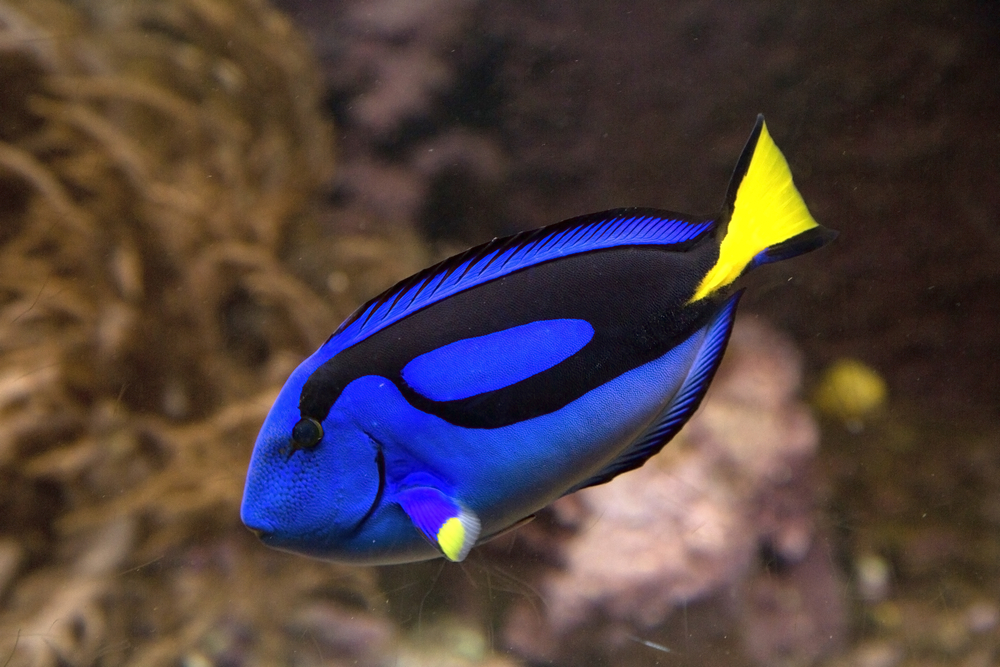

Origin: Indo-Pacific, Great Barrier Reef
Diet: Zooplankton in the wild
Size: Up to 12 inches
Scientific Name: Paracanthurus hepatus
Life Span: 8-20 years
The Regal Blue Tang is known by many names among which is the Blue Tang and Blue Hippo Tang. They are part of the surgeon fish family which the defining characteristic is the scalpel-like spine on the base of their tail. For the Blue Tang, the spine is yellow and located on the yellow part of their tail. It is used as a mode of defense towards threatening fish.
They eat algae which is instrumental in coral reefs because it keeps algae at low levels so that they don’t choke out corals. The Regal Blue Tang has a small mouth and a single row of teeth to help them get into the tight crevices of rocks and corals.
Regal Blue Tangs live in pairs or in small groups or schools of 8 to 14 individuals. Males will aggressively court the femals and they can quickly spawn. They release the eggs and sperm in the evening time where they float near the surface of the water because of a tiny droplet of oil in each egg. The eggs will hatch within 24 hours of being fertilized.
We don’t recommend eating them. It is used as bait fish in commercial fishing because of the strong odor on the flesh from certain toxins. If consumed by people, then it causes ciguatera poisoning. Symptoms include diarrhea, vomiting, numbness, itchiness, temperature sensitivity, dizziness, and weakness.
Yellow Tang
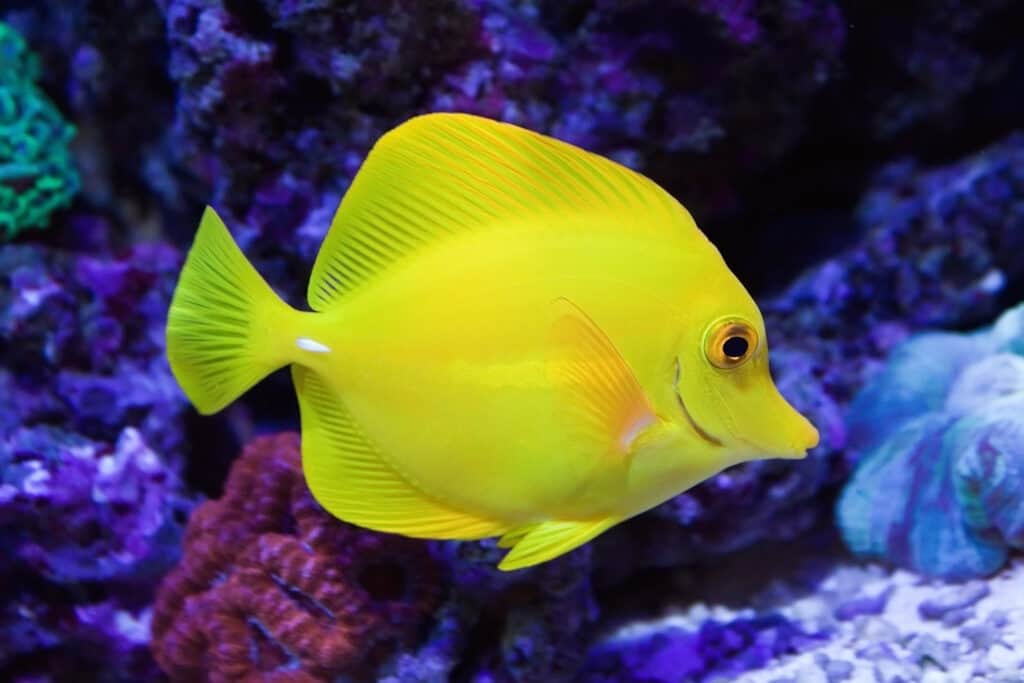
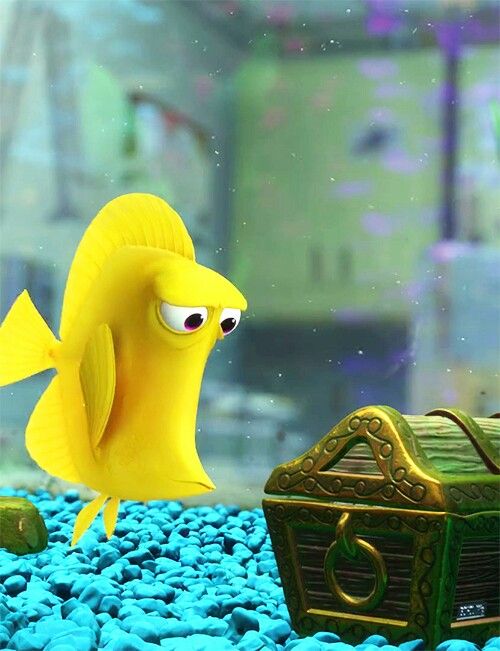
Origin: South Pacific Ocean near Hawaii
Diet: Algea and meat based aquarium food
Size: 7-8 inches
Scientific Name: Zebrasoma flavescens
Life Span: 30 years maybe longer
In Latin, the name “flavescens” means yellow. They are bright yellow during the day and at night that yellow dims developing a brownish patch and a horizontal white band. That horizontal white band also is a sign of stress from the fish.
They are part of the surgeonfish family. A defining characteristic is the scalpel-like spine on the base of the tail which are very sharp. It is easiest to see on the Yellow Tang because the spine is white in contrast to the yellow body. Our Yellow Tang in the predator tank has slapped his tail against the eel as a sign of warning to the eel to not mess with him.
Yellow tangs can be a cleaner to the algal growth that occurs on marine turtle shells. This is possible by the single row of teeth in its small protruding mouth.
They start life as clear larvae before development. While they are young, they are in schools with other Yellow Tangs and can actually be herded in the right conditions. They may even play “follow the leader” in and through the surrounding rocks. However, when they get older, they can become more aggressive towards other Yellow Tangs and will travel only in loose schools. Around the full moon, they will gather in order to spawn.
They are covered in a mucus that protects them from parasites and bacteria as well as making them less resistant to water which allows them to swim faster.
Royal Gramma
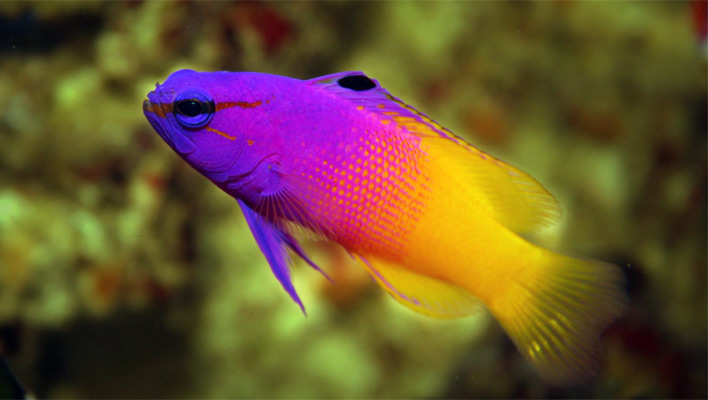
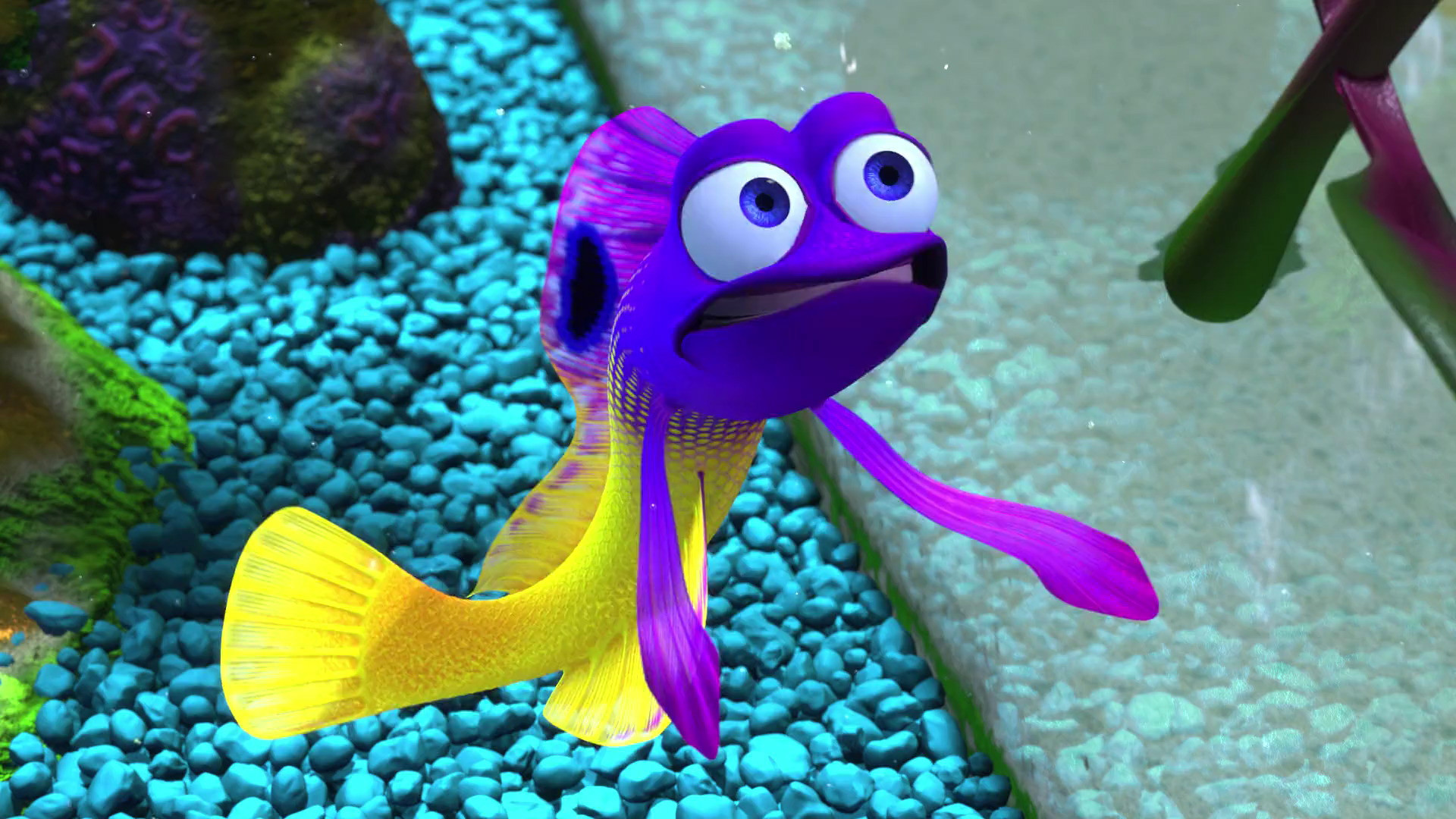
Origin: Western Atlantic Ocean
Diet: Zooplankton crustaceans
Size: 3 inches
Scientific Name: Gramma loreto
Life Span: 8-20 years
The Royal Gramma is also known as the Fairy Basslet, because of its iridescent colors. They are famously known for their royal purple to violet body, and their vibrant yellow tail. A black stripe also runs through the eye and its dorsal (upper) fin has a black dot on it to act as a false eyespot. This and their bright colors to blend in with corals allow them to hide from predators better. Overtime as the fish ages, the color begins to fade.
Royal Gramma are friendly with a lot of other species of fish and are known as “community fish”. The Royal Gramma is one of the smallest fishes that live among the coral. They have virtually no defense against predators other than their large numbers and camouflage. They are also very resistant to a lot of common diseases. These fish gather in groups of up to a dozen, consisting of one male and multiple females. They sleep in caves or under rocks.
These fish are mostly planktivorous, meaning they eat mostly plankton. However, they will also clean off ectoparasites, a parasite that lives on the skin of fish. They can learn to eat dead food such as crustaceans and fish for the aquarium.
Royal Gramma also have the amazing ability to change gender. All Royal Gramma are born female. After mating and producing eggs for many seasons, some of the Royals will change into males. They are then male for life and cannot change back. This happens not only with age but when a lack of males occurs. The dominate female will start to act like a male and then change into one within several days of this lack. Females lay egg that form a stick mass that clings to the edge of the nest until they hatch.
Skunk Shrimp


Origin: Pacific Ocean
Diet: parasites, dead tissue
Size: 2-2.4 inches
Scientific Name: Lysmata amboinensis
Life Span: Around 2 years
Skunk Shrimp are known as cleaner shrimp, simply because they really do clean fish. They will set up a “cleaning station” on top of live rock or coral and then wave their antenna until a larger fish stops by. Then they will begin their cleaning process by probing the fish all over to find parasites and dead fish flesh. They will sometimes even go in the mouth and gill openings!
This shrimp is known for its bright orange coloring on its sides and its scarlet stripe on its dorsal side (top side) which is bisected by a narrow white band. It also has white spots on its tail and three pairs of white antennas.
Skunk Shrimp are native to coral reefs across the tropics including the Red Sea and the Indo-Pacific Ocean. They live in tropical coral reefs that are usually between the depths of 5-40 meters (16-131 ft.) and are typically found in caves of reef ledges.
Skunk Shrimp live in mostly pairs, and while they are omnivorous they get most of their nutrients from the parasites and fish flesh they clean off of other fish.
All shrimp are born males but over time and with several molts, they become hermaphrodites. Hermaphrodites mean that they can both function as a male and a female in their mating behavior. This involves a pair of shrimps, one acting as male and the other as female. The male will follow the female who is brooding between 200-500 eggs attached to their pleopods, their tail. Then they will molt a few more times and then they will change roles between male and female.
In captivity, Skunk Shrimp have been known to be aggressive in groups of more than two. In such cases one pair of shrimps usually kill the rest. It is not known if in the wild they are socially monogamous.
Hermit Crab
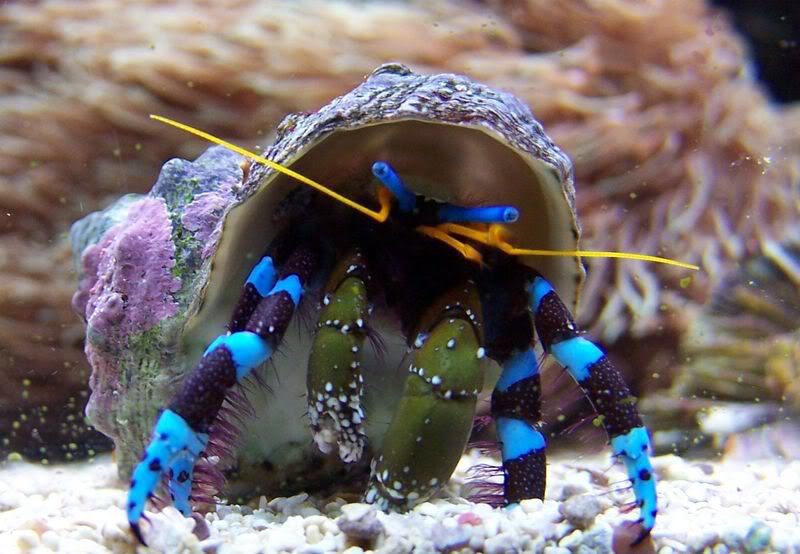
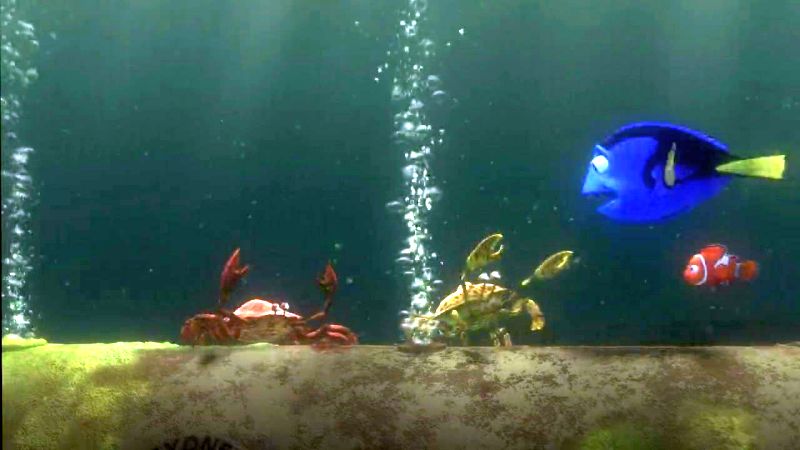
Origin: All over the world
Diet: Algae, plants, and uneaten fish food
Size: 2-10 centimeters
Scientific Name: Clibanarius tricolor
Life Span: Up to 30 years
Hermit crab can reach 0.5 to 16 inches in length, depending on the species. Hermit crab is usually reddish, orange or brown-colored, with or without purple spots on the body. Hermit crab has soft, asymmetrical abdomen, 10 legs, and 2 large claws. The left claw is larger in males for it serves as a weapon against predators such as cuttlefish, squid, octopus and different types of fish. Hermit crabs may fight others for the use of different abandoned shells, usually of sea snails, to protect its soft body and provide a moist environment for its gills. They have two long ocular stalks with eyes on the top and antennas which serve as sensory organs.
Despite their name, Hermit Crabs actually live in large colonies of over 100 crabs.
Hermit Crabs are omnivores. They will eat plankton and algae and scavenge for dead matter and detritus in the sand. Crabs find it easiest to collect the plankton by utilizing their claws to guide food into their mouths and suck in anything that is within reach. Their small mouths allow them to munch slowly as they move along to other things of interest.
Sea Snail
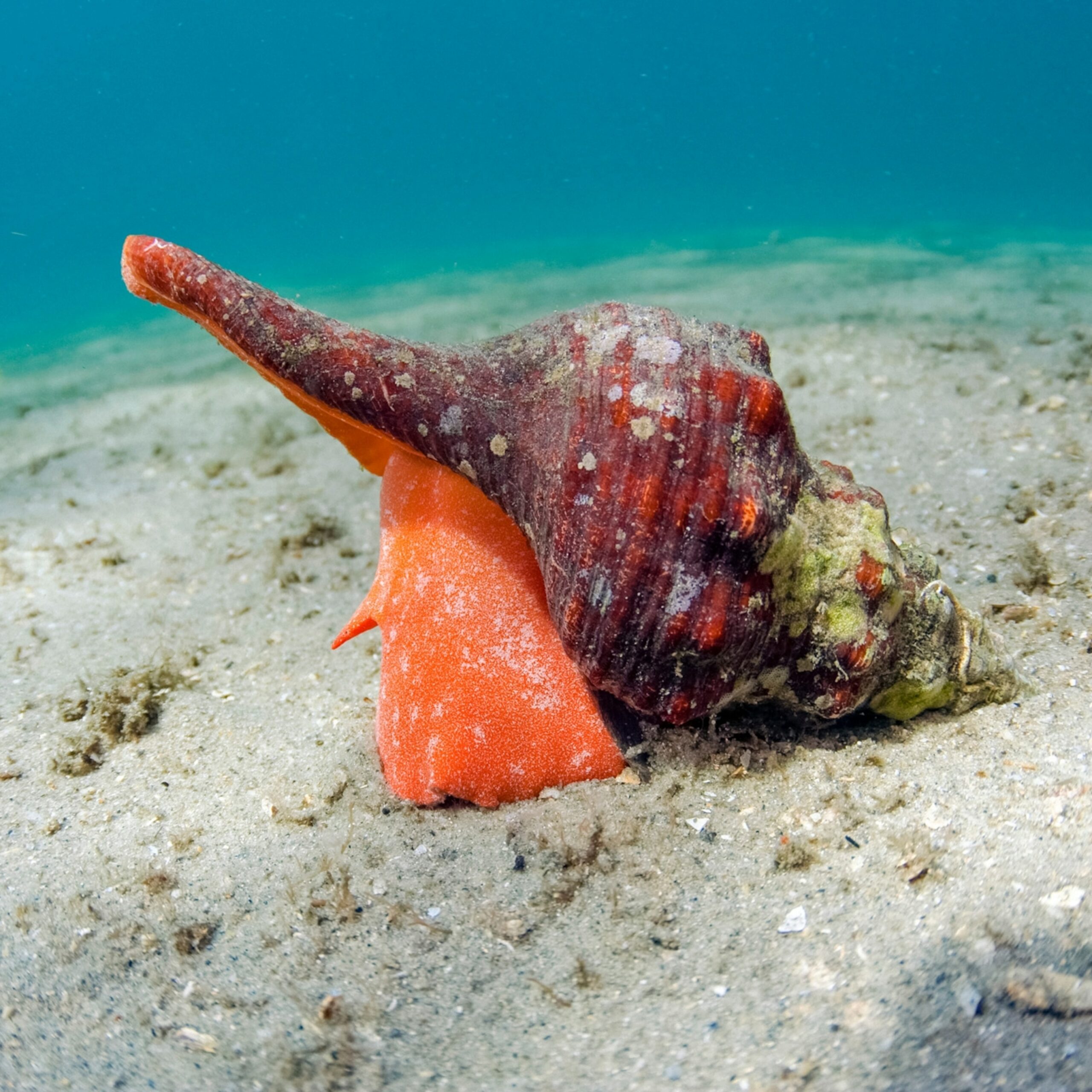
Origin: Everywhere
Diet: Detritus
Size: 3-4 inches
Scientific Name: Nassarius spp
Life Span: 2 years, possibly longer
Sea snails are also known as marine gastropods. However, the class Gastropoda includes freshwater and land snails as well.
Sea snails and hermit crabs are considered our clean up crew. It is a natural way to keep the tanks and rocks clean of algae and waste. They will eat left over fish food and detritus. They sift through the sand, stirring it up to release this extra waste and to oxygenate the sand.
They have a very good sense of smell through a siphon that protrudes from their shell. This allows them to smell all the extra food and they can move relatively quickly towards the food.
For the aquarium industry, they are collected from the shorelines of Mexico, to the Caribbean, all the way to the Indonesia. They are able to survive a wide range of environmental conditions that allow them to be hardy critters in the aquarium tank.
Golden Damselfish

Origin: Indian Ocean, Western Pacific
Diet: Omnivore
Size: 2 ½ inches
Scientific Name: Dascyllus aruanus
Life Span: Up to 15 years
Damselfish are hard and somewhat aggressive species. They are a good species of fish for the new aquarist as they are able to survive a multitude of environmental parameters and is used as a biological stabilizer in cycling new aquariums. To reduce the aggressive behavior they may be homed with pre-established or in unison with other species.
Damselfish are also hermaphrodites which means that they are all born as males and the most dominant male will go through a biological change and transform into a female.
Marine Betta Fish
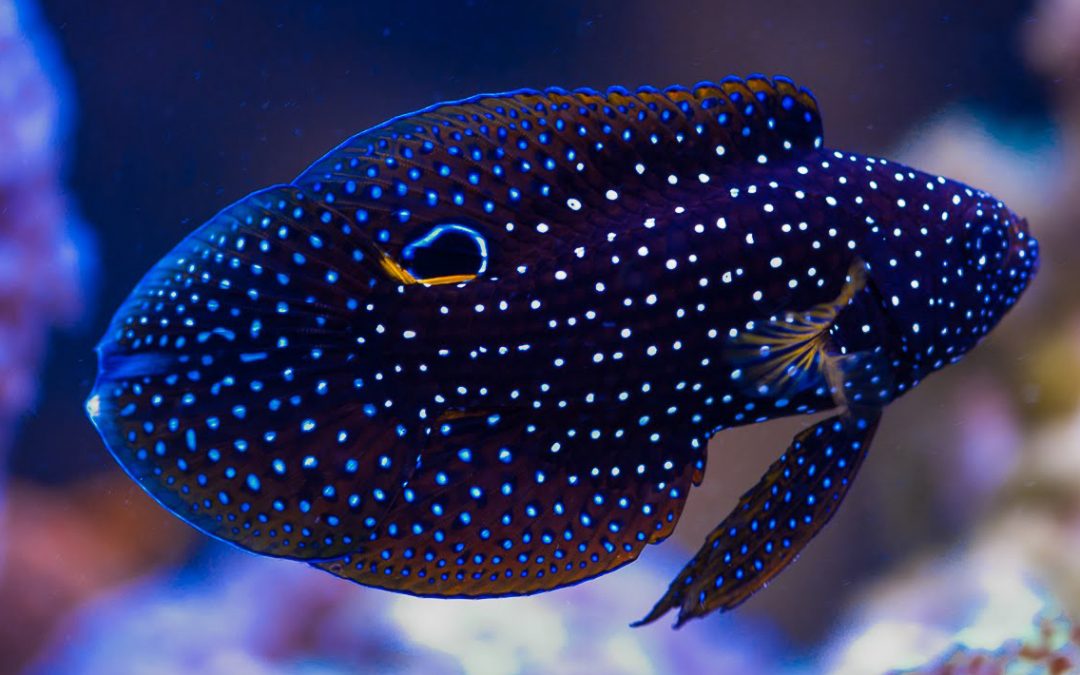
Origin: Indo-Pacific: Red Sea and East Africa to Tonga
Diet: Carnivore
Size: 8 Inches
Scientific Name: Calloplesiops altivelis
Life Span: 10 plus years
This fish is also known as the Comet. They are not true betta fish but are called bettas due to their similar body shape and long elegant fins like the freshwater bettas.
They are shy when they are first introduced into a tank. When they feel threatened they may show an intimidation type response by mimicking the head of a moray eel. They eye spot on their tail may look like the eye of a moray. Marine Bettas are nocturnal fish and will hunt for live prey at night. Otherwise they will spend their time under overhands and caves. They use their long fins to herd prey to their mouth and make them appear larger and more threatening to predators.
Bubble Tip Anemone
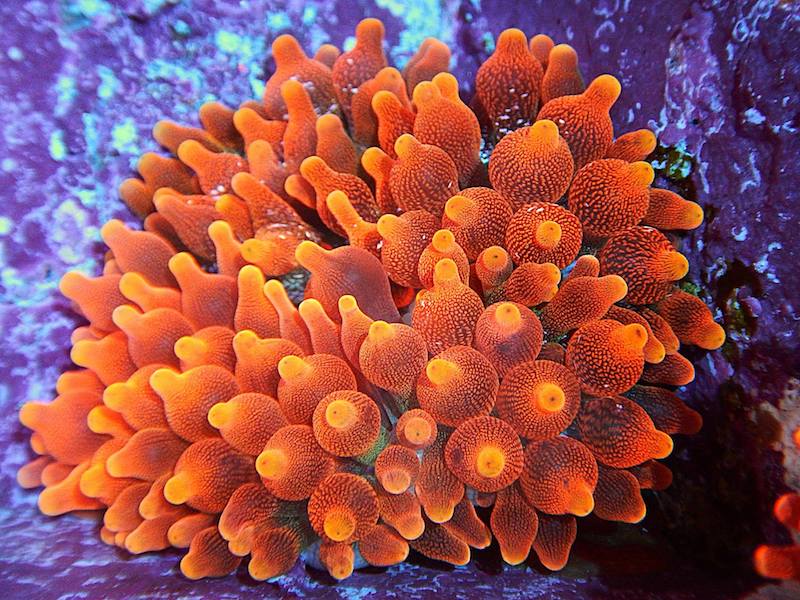
Origin: Indo-Pacific area
Diet: Food brought by clown fish
Size: 6-12 inches
Scientific Name: Entacmaea quadricolor
Life Span: 2-5 years
Anemones have many symbiotic relationships with animals in the ocean. The most common one known is the anemonefish that lives within the anemones providing it shelter and protection. In return the anemonefish also gives the anemone protection and nourishment.
The other symbiotic relationship is the zooxanthellae that lives within it, providing it nourishment from the sun. These are single-celled organisims that photosynthesis providing up to 90% of the anemone’s energy for metabolism, growth, and reproduction. In return, the anemone gives them nutrients, carbon dioxide, and an elevated position towards the sun.
The tentacles of the anemone allows it to filter feed, feeling through the water and searching for waste and debris. They are able to even eat fish that do not have that protective mucus layer on them. The fish are caught by the tentacles of the anemone and brought to the center where the mouth is and swallowed.
Anemones do not have a skeletal structure. This allows them the freedom to either move around the tank or to stay in one place. It is up to them where you will see them!
Bubble Coral
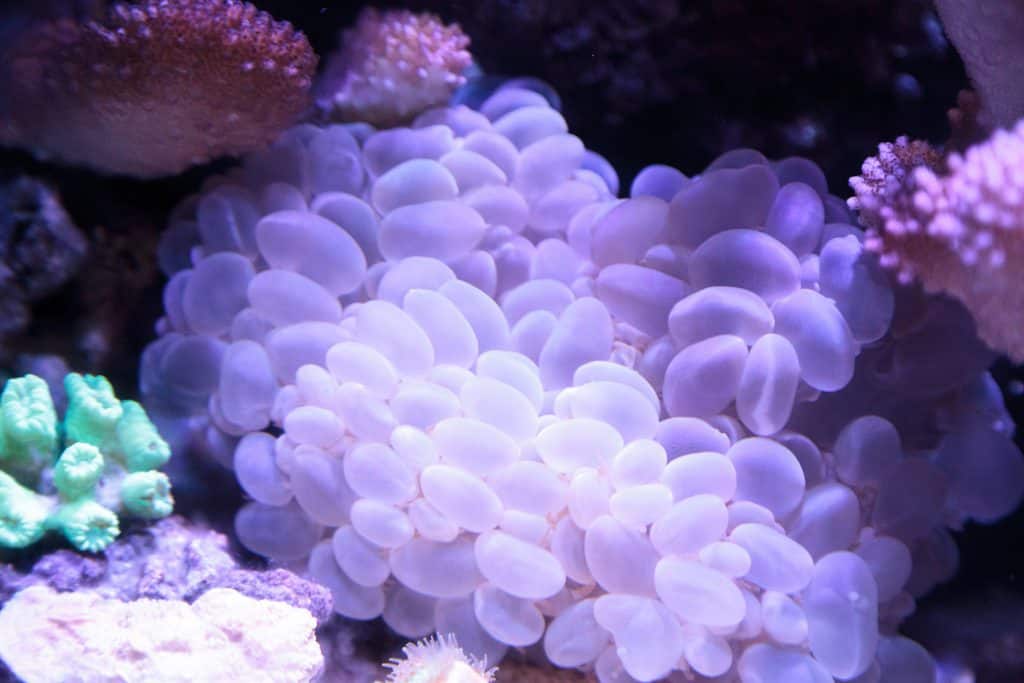
Origin: Shallow reef environments
Diet: small meaty items
Size: 3-12 inches
Scientific Name: Plerogyra sinuosa
Life Span: Unknown
There are several names for this species. They are also known as Grape Coral, Bladder Coral, Pearl Coral and Branching Bubble Coral.
Bubble coral has the ability to increase their surface area according to the amount of light available to them. Thus, in the day time, their bubbles will increase and be fuller and at night, they will shrink and tentacles will appear, reaching out for food.
They are subject to threats of climate change and destruction of the reef.
Bubble Corals have a symbiotic relationship with the zooxanthellae that lives within it, providing it nourishment from the sun. These are single-celled zooxanthellae that photosynthesis providing up to 90% of the anemone’s energy for metabolism, growth, and reproduction. In return, the anemone gives them nutrients, carbon dioxide, and an elevated position towards the sun.
It can reproduce both sexually and asexually. Sexually means that they will release eggs and sperm into the water where they will settle in the reef and grow. Asexually occurs through fragmentation which is when a branch of the colony breaks off and continues to grow.
Our Bubble Coral is also host to the Ocellaris Clownfish in this tank. You will find the clownfish on the right hand side of the tank, swimming in and out of the Bubbles’ bubbles.
Zoanthids

Origin: Great Barrier Reef, Caribbean, South Pacific
Diet: Plankton, algae, small meaty foods
Size: 1-2 inches
Scientific Name: Zoantharia spp
Life Span: Up to 250 years
Zoanthids are in the order of cnidarians which is the same order as jellyfish. They come out in different colonizing formations and colors. They are found as polyps that are attached to sediment, sand and rock.
These guys are unique in that they can incorporate sand and small material into their tissue to help create their structure. Their tentacles are all marginal and filter feed for the plankton and algae floating in the water.
They have a symbiotic relationship with the zooxanthellae. The zooxanthellae provide it nourishment from the sun by photosynthesizing up to 90% of the coral’s energy for metabolism, growth, and reproduction. In return, the coral gives them nutrients, carbon dioxide, and an elevated position towards the sun.
Some zoanthids contain highly toxic substances called palytoxin. Even in small doses, the toxin could be fatal if it is ingested or enters the bloodstream.
Mushroom Coral
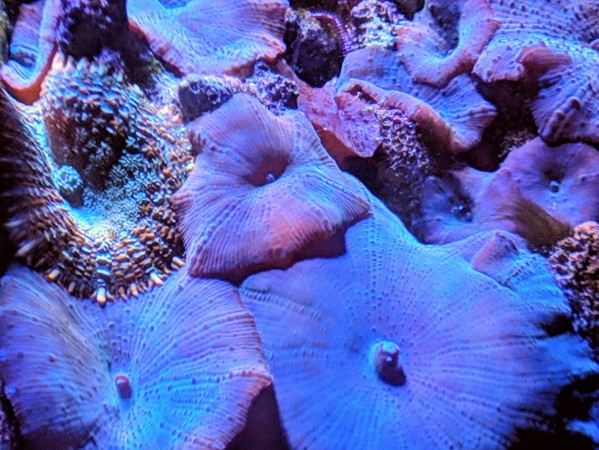
Origin: Caribbean
Diet: Crustaceans, small fish, brine shrimp
Size: 1-2 inches
Scientific Name: Fungiidae sp
Life Span: 2-13 years
They are of the phylum Cnidaria which is the same phylum that the jellyfish are in. There are many species in this family that range to solitary corals to colonial species. The ones that are in this tank are colonial. Each one of those individual “mushrooms” is one individual that are living together in a colony. They can remain detached from the sand or rock so that they could move around if they wanted to.
They are very hardy corals which is perfect for the beginning aquarists. They can tolerate high levels of nitrates and other organic compounds that will usually kill other fish and corals. However, they will brighten and be healthier with less levels of nitrates and organic compounds.
These corals can be blue, red, green, brown, purple and sometimes with stripes, spots, or mottled color variations.
They will also reproduce until they cover the substrate on what they grow.
These corals will also host the zooxanthellae in a symbiotic relationship. The zooxanthellae provide it nourishment from the sun by photosynthesizing up to 90% of the coral’s energy for metabolism, growth, and reproduction. In return, the coral gives them nutrients, carbon dioxide, and an elevated position towards the sun.
Black and White Damsel Fish
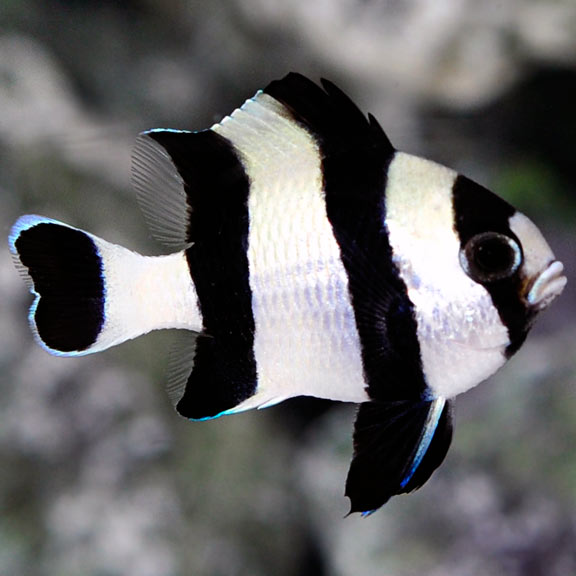
Origin: Indian Ocean, Western Pacific
Diet:
Size: 2 ½ inches
Scientific Name: Dascyllus aruanus
Life Span: Up to 15 years
Damselfish like to be in schools of even numbers. They can be feisty and territorial and some are not even reef safe, eating the corals.
Moorish Idol
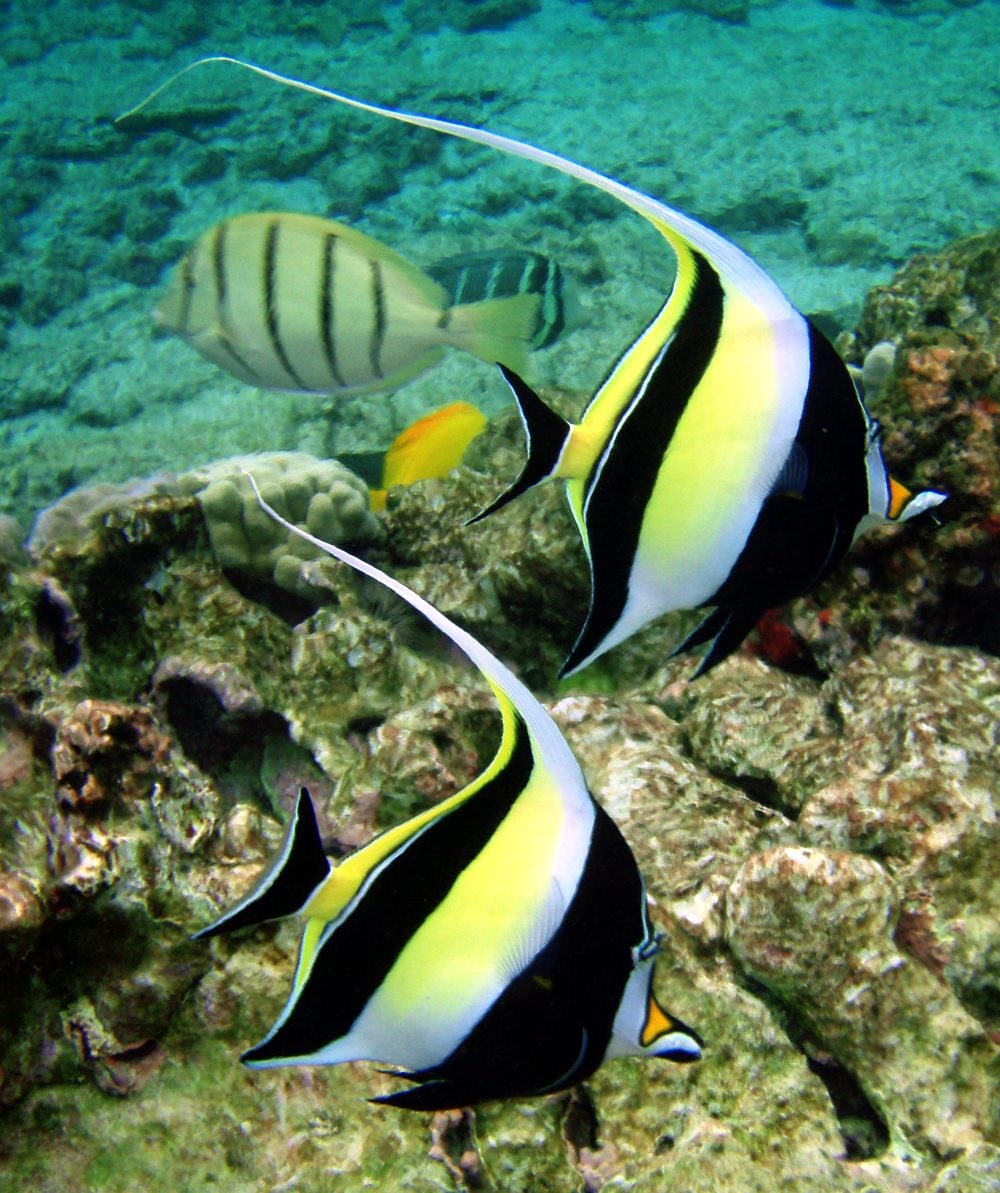
Origin: Indian Ocean, Red Sea, Tropical Pacific
Diet: algae
Size: 9-10 inches
Scientific Name: Zanclus cornutus
Life Span: 2-4 years
Moorish Idols are finicky and hard to adjust to captivity. They have an omnivorous diet which is difficult to replicate in an aquarium and they do eat corals and sponges which we have in this tank. Also, the full grown adult size would be too big for this tank!
We do have a fish in the Crustacean tank that are called Bannerfish. They look a lot like the Moorish Idol with a few patterning differences and are a lot easier to keep.
Porcupine Pufferfish
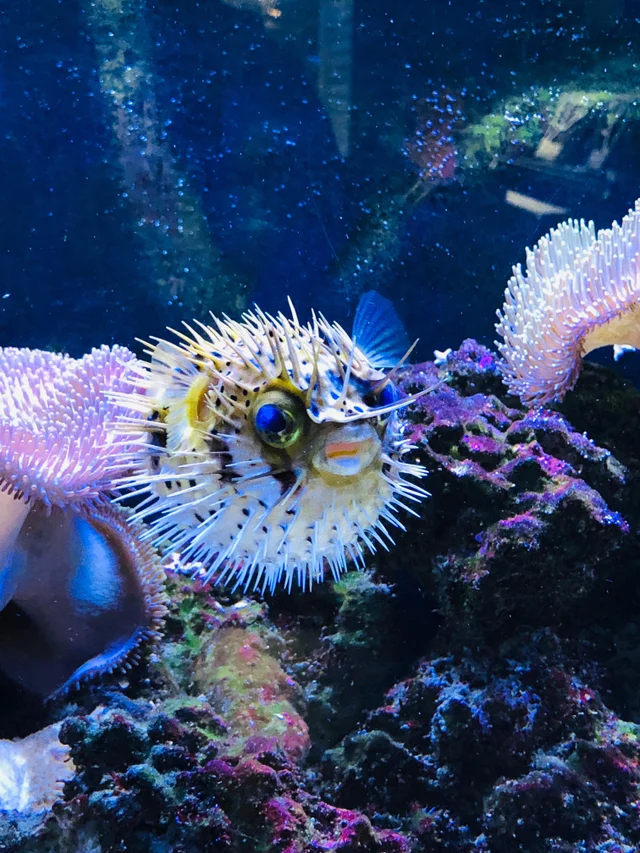
Origin: Subtropical ocean
Diet: shrimp, algae, small fish
Size: 13-15 inches
Scientific Name: Lophodiodon calori
Life Span: 10-15 years
Small tankmates for the pufferfish is not a good idea because they may become dinner. So most of the fish and invertebrates that we have in this tank will not be able to live with him. Also, look at his size! A full-grown adult will not fit in this tank.
Caribbean Sea Star
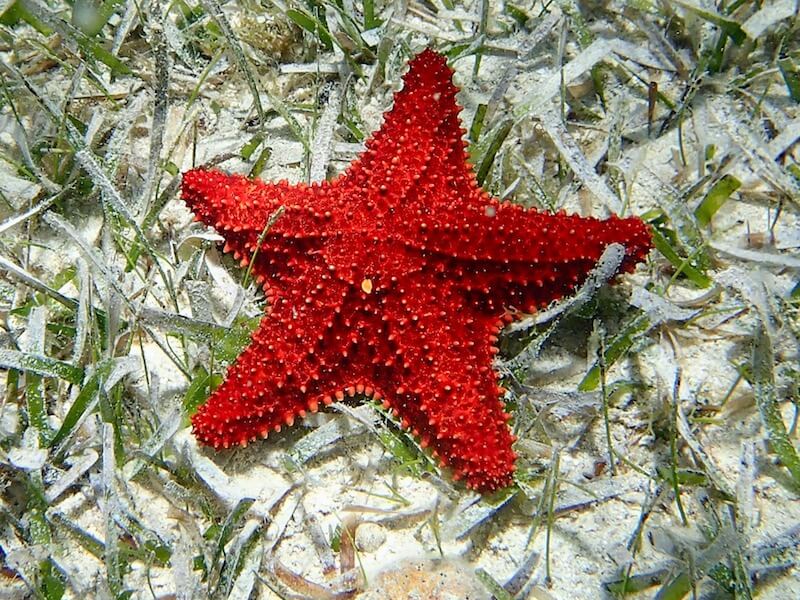
Origin: Western Atlantic Ocean and the Caribbean Sea
Diet: Seabed sediment, algae, sponges, and small invertebrates
Size: 50cm (20in)
Scientific Name: Oreaster reticulatus
Life Span:
Harvesting or collecting these sea stars is illegal in many waters including Florida, where we obtain most of our animals. Their habitat requires either sandy bottoms and coral rubble for the adults and seagrass meadows for the juveniles.
Their diet would not do well in this tank because of the sponges and small invertebrates that we have in here. Large numbers of individuals like to gather together when it is breeding season. We obviously don’t have the space for this, not even for one full grown adult!
Flame Scallop
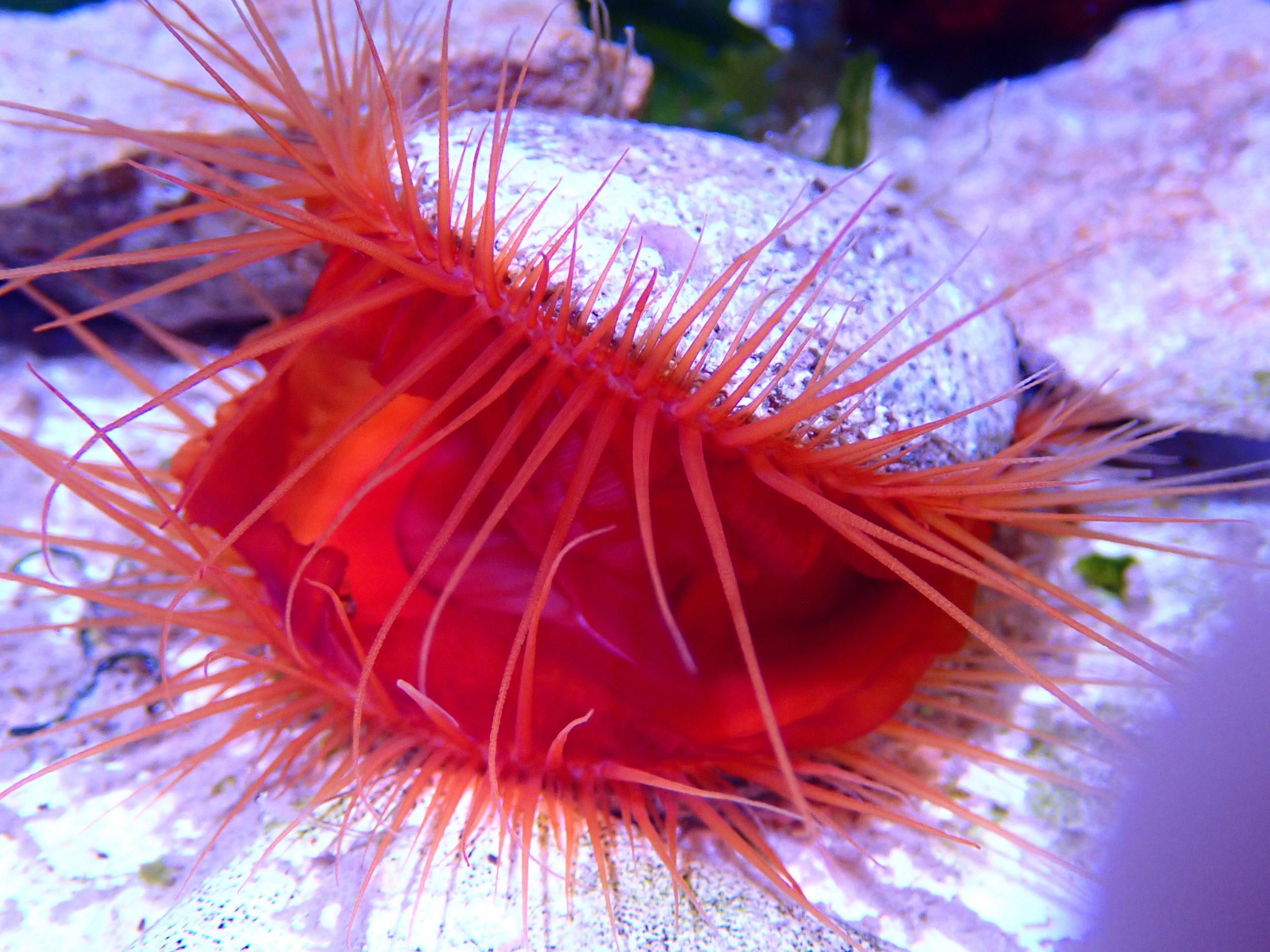
Origin: Caribbean and Indo-Pacific
Diet: Phytoplankton
Size: 1-4 inches
Scientific Name: Oreaster reticulatus
Life Span: 1-3 years
The Flame Scallop is a bivalve mollusk and has the ability to propel itself through the water if it feels threatened. The shell is rough, covered in small bumbs and the inside has bright red appendages to filter through the water column for its food. It does not rely on photosynthesis.
It likes to nest itself with the live rocks and corals and is a very peaceful creature.
Reef System
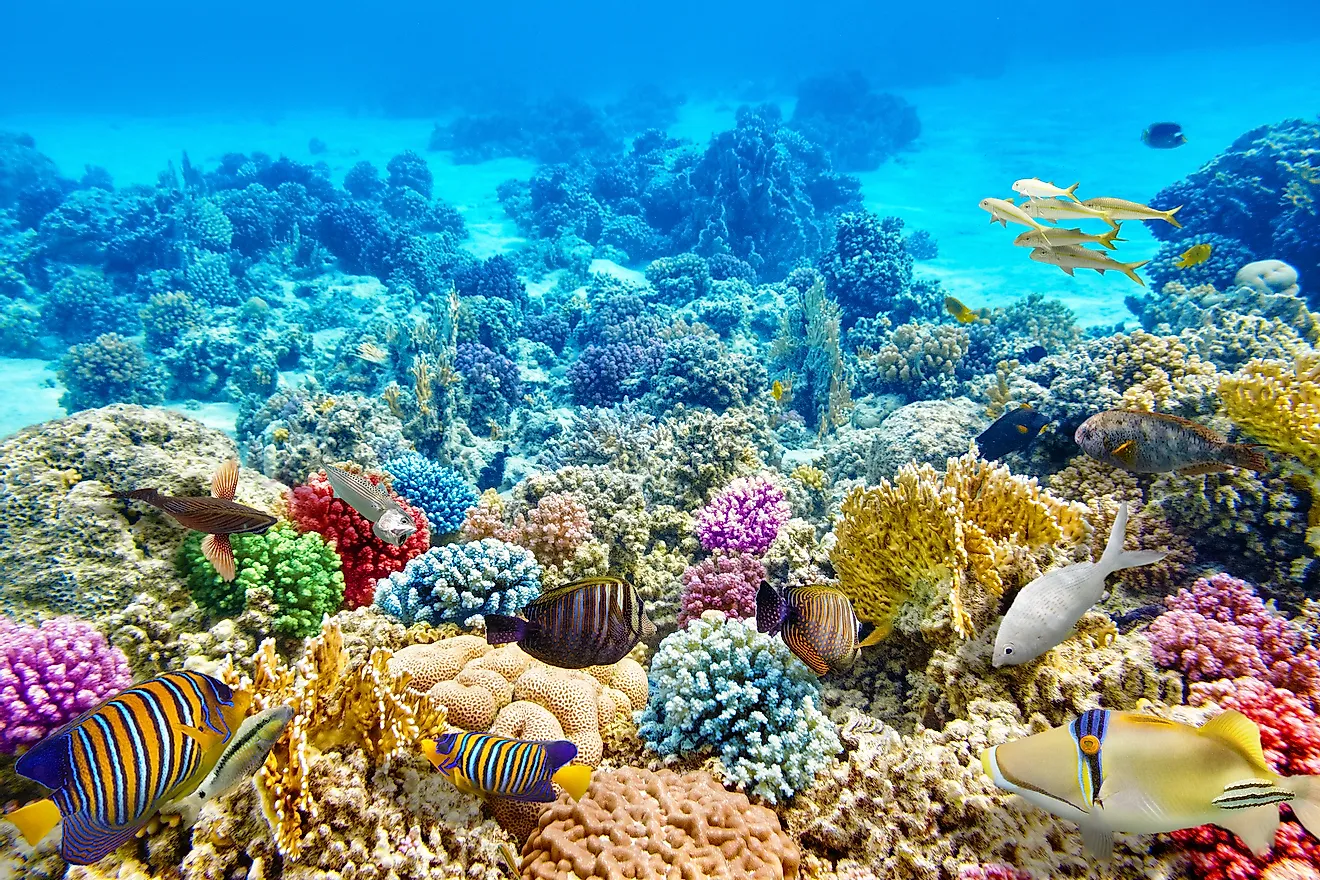
Another name for coral reefs are “rainforests of the sea.” They were formed after the last glacial period when all that melting ice rose the sea levels making reefs less than 10,000 years old.
The reefs had to grow as fast as the ice melted to make sure that they had sufficient light, otherwise they would “drown” from the lack of light.
Coral Reefs are found in shallow tropical water and around volcanic islands. The heat from the volcano provides the nutrition and warmth that is needed to provide the right conditions for the coral reef. There are some small scale deep and cold water reefs.
Most of them require warm, shallow, clear, sunny, and agitated water with few nutrients. They occupy only less that 0.1% of the world’s ocean area yet houses at least 25% of all the marine species. This includes fish, mollusks. Worms, crustaceans, echinoderms, sponges, tunicates, and other cnidarians.
The coral reefs service tourism, fisheries and shoreline protection and its economic value is estimated to be between US$30-375 billion!
Reef ecosystems are very fragile because they are sensitive to water conditions. If there is too many nutrients in the water, it can kill corals. There is also the threat of rising temperatures, acidification, overfishing, sunscreen overuse, and runoffs and seeps from harmful land-use practices.
Many restoration practices have come into play to help protect and preserve the coral reefs. There is one called coral aquaculture or coral gardening. This allows the early stages of coral growth to be protected when they are most likely to die from water conditions. By preserving them through this stage, they can be replanted on the reef more abundantly.
Another effort is to supply more substrate for more corals to find homes. Ironically this substrate could include vehicle tires, scuttled ships, subway cars and formed concrete.
There was also a bio control to reduce the amount of invasive algae species. This invasive species chokes out the corals and anemones, killing them and putting the reef in danger. The collector urchins are good for eating this type of algae but divers have also gone down and removed them by hand.
Please be aware and protect our oceans!




